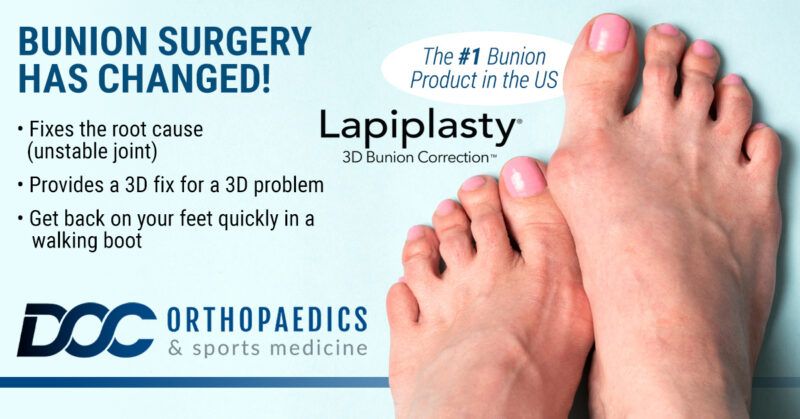
Lapiplasty Versus Osteotomy: Which is right for you?
Lapiplasty Versus Osteotomy: Which is right for you?
According to the American Orthopaedic Foot and Ankle Society (AOFAS), as many as 55% of older women have bunions, but bunions can affect anyone at any age.
Bunions are bony protrusions, or bumps, that appear on the outside of the big toe. These protrusions have been commonly considered an overgrowth of bone. In fact, some surgical bunion treatments involve removing part of the bone based on this premise. The most common surgical bunion treatment is an osteotomy.
What is an osteotomy?
An osteotomy involves shaving or cutting the part of the bone that protrudes from your foot. It can also involve cutting the first metatarsal to shorten and realign the bones. Pins hold the newly segmented bones in place, tight tendons and ligaments are released to further align the foot, and loose tendons and ligaments are tightened.
Of course, full recovery times vary depending on the extent of the realignment required. However, the average recovery from traditional bunion surgery can take up to six months or even a year.
The most common complications from an osteotomy are ongoing pain, swelling, and stiffness. Recurrence of the bunion is also common, as traditional bunion surgery fails to address the root cause of the problem.
What is lapiplasty?
Traditional bunion surgery takes a two-dimensional approach to what has been most recently determined to be a three-dimensional problem. A newer technique—lapiplasty—takes a more effective three-dimensional approach.
Bunions are, in fact, not an overgrowth of bone. Instead, they are a result of a deformity of the foot’s anatomical structure. In almost all bunion cases, this deformity is complex and occurs in three dimensions. In other words, bunions involve three shifts in the first metatarsal bone, more commonly known as your big toe. These shifts can cause bones to rotate out of alignment causing pain and abnormal wear.
Lapiplasty is designed to restore normal anatomy to the affected joints, fixing the unstable joint at the base of the toe and correcting the rotation. Best of all, because lapiplasty treats the underlying problem, it is typically a permanent solution to the bunion deformity so that it will not recur. In addition, recovery time is frequently as little as just 10 days.
Talk to a specialist to understand what’s right for you
If you’re concerned about the bunion you have – or those you may be developing – you may want to visit an orthopaedist specializing in foot and ankle issues. DOC has two such specialists: Dr. Justin Daigre and Dr. Matthew Nalamlieng.
Dr. Justin Daigre is board-certified in orthopaedics and fellowship trained in foot and ankle surgery. His expertise and caring approach make him one of the best foot and ankle surgeons in Alabama. He earned a B.S. in Biology from UAB, completed medical school at South Alabama in Mobile, AL and then moved to West Virginia University to complete his orthopaedic training. He spent a year in foot and ankle fellowship training in Columbus, Ohio, and has now returned to provide care for the community where he was raised.
Dr. Daigre is an active member of the American Orthopaedic Foot and Ankle Society and a diplomat of the American Academy of Orthopaedic Surgeons. He works with two orthopedic implant companies: In2Bones and Treace Medical. With In2Bones, he helps design orthopedic products that are used in the operating room. Dr. Daigre helps teach other surgeons how to use Treace Medical’s Lapiplasty system, the revolutionary 3D bunion correction system.
Dr. Nalamlieng is a board-certified podiatrist, who focuses on the treatment of chronic and acute foot conditions. He is certified in foot, rearfoot and reconstructive ankle surgery with the American Board of Foot and Ankle Surgery (ABFAS). He can and will address all foot problems including toe pain, forefoot pain, heel pain, bunions, hammertoes, flat feet, tendinitis and arthritis.
Dr. Nalamlieng earned his Bachelor of Science at The Master’s College in Santa Clarita, California. He then completed his Doctor of Podiatric Medicine at Western University of Health Sciences, College of Podiatric Medicine in Pomona, California, graduating as part of the Pi Delta Honor Society.
During his three-year integrated podiatric medicine and surgery residency with an added credential in reconstructive rearfoot/ankle surgery at the White Memorial Medical Center in Los Angeles, Dr. Nalamlieng focused on foot and ankle sports injuries, lower extremity trauma, joint replacement for end-stage ankle arthritis, and reconstruction of complex foot and ankle deformities.
He went on to serve as a member of the Center for Limb Preservation & Advanced Wound Care at White Memorial Medical Center and completed additional training in advanced techniques in lower extremity reconstruction at USC Keck Medical Center as a chief resident.
About DOC Orthopaedics
Since 1972, the specialists at DOC Orthopaedics and Sports Medicine have been committed to providing exceptional orthopaedic care through innovative techniques, quality services, patient communication, and education. With specialties ranging from general orthopaedics and physical therapy to sports medicine, joint replacement, and more, the doctors at DOC Orthopaedics and Sports Medicine can provide local expert care for any orthopaedic disorder or injury and help put your life back in motion.

